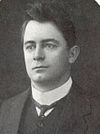Regierung Hughes III
Die Regierung Hughes III war die dreizehnte Regierung Australiens. Sie amtierte vom 17. Februar 1917 bis zum 10. Januar 1918. Alle Mitglieder der Regierung gehörten der National Party of Australia an.
Die Vorgängerregierung war eine Minderheitsregierung der National Labor Party (NLP) – einer Abspaltung der Wehrpflichtbefürworter der Labor Party – unter Premierminister Billy Hughes, die von der Liberal Party (LP) unterstützt wurde. Im Februar 1917 vereinigten sich die NLP und die LP zur Nationalist Party of Australia, die die dritte Regierung Hughes stellte. Bei der Parlamentswahl im Mai 1917 gewann die Nationalist Party eine absolute Mehrheit in Repräsentantenhaus und Senat.[1] Am 20. Dezember 1917 fand, wie schon im Oktober 1916, erneut eine Volksabstimmung über die Einführung der Wehrpflicht statt. Die Mehrheit gegen die Wehrpflicht war noch größer als bei der ersten Abstimmung. Premierminister Hughes trat, wie vor der Abstimmung im Fall einer Niederlage versprochen, am 8. Januar zurück, blieb aber Vorsitzender der Nationalist Party. Generalgouverneur Ronald Munro-Ferguson beauftragte daraufhin Hughes erneut mit der Bildung einer Regierung.[2][3]
Ministerliste
| Amt | Minister | Amtszeit | Bild |
|---|---|---|---|
| Premierminister und Generalstaatsanwalt | Billy Hughes | 17. Februar 1917 – 10. Januar 1918 | |
| Marineminister | Joseph Cook | 17. Februar 1917 – 10. Januar 1918 | |
| Schatzminister | John Forrest | 17. Februar 1917 – 10. Januar 1918 | |
| Verteidigungsminister | George Pearce | 17. Februar 1917 – 10. Januar 1918 | |
| Vizepräsident des Executive Council | Edward Millen | 17. Februar 1917 – 16. November 1917 | |
| Littleton Groom | 16. November 1917 – 10. Januar 1918 | ||
| Minister für Repatriierung | Edward Millen | 28. September 1917 – 10. Januar 1918 | |
| Minister für Arbeit und Eisenbahn | William Watt | 17. Februar 1917 – 10. Januar 1918 | |
| Minister für Inneres und Territorien | Patrick Glynn | 17. Februar 1917 – 10. Januar 1918 | |
| Generalpostmeister | William Webster | 17. Februar 1917 – 10. Januar 1918 | |
| Minister für Handel und Zölle | William Archibald | 17. Februar 1917 – 10. Januar 1918 | |
| Honorary Minister | Edward Russell | 17. Februar 1917 – 10. Januar 1918 | |
| Littleton Groom | 17. Februar 1917 – 16. November 1917 | ||
Weblinks
- Parliamentary Handbook for the 45th Parliament. (PDF; 13,4 MB) Part 6: Historical information on the Australian Parliament – Ministries and Cabinets. Parliament of Australia, S. 523, abgerufen am 22. April 2019 (englisch).
Einzelnachweise
- ↑ Stephen Barber: Federal election results 1901–2016—Reissue 2. (PDF; 2,9 MB) Parliament of Australia, S. 5 f, 23, 139, abgerufen am 27. April 2019 (englisch).
- ↑ L. F. Fitzhardinge: Hughes, William Morris (Billy) (1862–1952). In: Douglas Pike (Hrsg.): Australian Dictionary of Biography. Band 9. Melbourne University Press, Carlton (Victoria) 1983, ISBN 0-522-84273-9 (englisch).
- ↑ Johannes H. Voigt: Geschichte Australiens. Alfred Kröner, Stuttgart 1988, ISBN 3-520-48801-9, S. 210–214.
Auf dieser Seite verwendete Medien
Senator George Pearce
Autor/Urheber: Reid, G. H. (George Houstoun), Sir, 1845-1918, Lizenz: No restrictions
Identifier: australiafiscalp00reid (find matches)
Title: Australia and the fiscal problem ..
Year: 1903 (1900s)
Authors: Reid, G. H. (George Houstoun), Sir, 1845-1918
Subjects: Tariff -- Australia Free trade
Publisher: London : Sir Joseph Causton & Sons, Ltd.
Contributing Library: University of California Libraries
Digitizing Sponsor: MSN
View Book Page: Book Viewer
About This Book: Catalog Entry
View All Images: All Images From Book
Click here to view book online to see this illustration in context in a browseable online version of this book.
Text Appearing Before Image:
ears later at Maitland by the Prime Ministerof the Australian Commonwealth. The firstAmerican duties ran from 5 to 15 per cent, advalorem. They were to disappear when theindustries to be encouraged had acquired thepromised perfection. In America, where thebounty of Nature counteracts the effects ofpolitical meddling, strength seems to come slowlywith adventitious aid, and appetite to grow bywhat it feeds on. The import duties still remainto protect the eternal infancy of industries, andin i8go were equal to 30 per cent, ad valoremupon the total imports. To take two leadinglines—the duty on cotton was in 1790 7^ percent. It was raised in 1794 to 12^ per cent., in1797 to 15 per cent., in 1804 to I7;- per cent.,and in 1812 to 35 per cent. During the sameyears the duty on woollens was increased from 5to 30 per cent, ad valorem. Protection, a Temporary Specific.The history of import duties for protectivepurposes has been similar in the Australiancolonies. In the beginning the duties were
Text Appearing After Image:
Rembrandt Studios, Block Arcade, Melbourne Thk Hon. p. McM. GLYNN, M.P. Copyright FEDERAL TARIFF AND FISCAL REFORM 33 even lower than those imposed in thefirst session of the American Congress. In1900 the duties on taxed articles, exclusive ofstimulants and narcotics, were equal to anaverage of 23 per cent, ad valorem for all theStates. As the duties were practically forrevenue purposes only in New South Wales,and were on a moderate scale in WesternAustralia, it will be seen how burdensome wastheir character in some of the other States.The Dominion of Canada also, at a time whena policy was required to keep a party together,adopted Protection as a temporary specific foran assumed sluggish industrial condition.Twenty years later Sir Wilfrid Laurier foundhow difiicult it is to even temper with modera-tion a high protective policy. I can assureyou that no one knows the difficulty of dealingwith vested interests, although admittedly theduties were still far too high. Power in Defence of P
Note About Images
The Third Hughes Ministry in early 1917
This image shows a photograph of William Archibald, taken prior to 1926. Under Australian law, all photographs taken in Australia before 1955 are in the public domain. This image is in the public domain under both Australian copyright law and US copyright law. http://nla.gov.au/nla.pic-an22438642
Commonwealth Coat of Arms of Australia granted by Royal Warrant signed by King George V on 19 September 1912.
IMPORTANT:This image is an artist's interpretation of the original (1912) official version of the Commonwealth Coat of Arms shown in Commons on the Australian coat of arms page. A variant of the original, with a transparent background, is shown on this page.
| “ | Quarterly of six, the first quarter Argent a Cross Gules charged with a Lion passant guardant between on each limb a Mullet of eight points Or; the second Azure five Mullets, one of eight, two of seven, one of six and one of five points of the first (representing the Constellation of the Southern Cross) ensigned with an Imperial Crown proper; the third of the first a Maltese Cross of the fourth, surmounted by a like Imperial Crown; the fourth of the third, on a Perch wreathed Vert and Gules an Australian Piping Shrike displayed also proper; the fifth also Or a Swan naiant to the sinister Sable; the last of the first, a Lion passant of the second, the whole within a Bordure Ermine; for the Crest on a Wreath Or and Azure A Seven-pointed Star Or, and for Supporters dexter a Kangaroo, sinister an Emu, both proper. | ” |
William Watt, Australian politician
























